TerraN_EmpirE
Tyrant King
A little bit of the Transhumanist ideals
New “Iron Man” Special Forces Exoskeleton Stops Bullets With Liquid Armor
CNN
IN BRIEF
We may have a new combat exoskeleton prototype in 2018. It will have body armor that makes use of a liquid that solidifies in milliseconds, and a tiny, powerful engine for recharging the suit's systems.
We’ve all seen what Iron Man can do in the movies, and it’s rather impressive—what with all the flying and absorbing bullets.
Ultimately, all of his abilities come from the incredible technology behind his suit. And it’s to this inspiration that Special Operations Command (SOCOM) is turning for their future combat exoskeleton prototypes, which are to be ready in 2018.
An initial design of the TALOS exoskeleton. Credit: Army
An initial design of the TALOS exoskeleton. Credit: Army
LIQUID ARMOR
In 2013, SOCOM expanded their development of such a suit, which they call the Tactical Assault Light Operator Suit (TALOS). Navy SEALs or Special Forces would use these suits for special operations.
However, unlike the metallic, clunky suit of Iron Man, these military operators need to move with great mobility; therefore, the suits will be made with a “liquid body armor” that transforms into solid within milliseconds when a magnetic field or an electric current is applied through the material.
The technology is being developed by scientists at the Massachusetts Institute of Technology. A Polish company, Moratex, is working on a similar kind of liquid body armor, using a non-Newtonian liquid called Shear-Thickening Fluid (STF).
Essentially, what’s being designed is a suit of armor that remains soft and malleable during normal operations, but hardens instantaneously at the point of contact—deflecting and dispersing the immense destructive energy produced by a hit from an enemy round or shrapnel.
POWERED BY A SMALL ENGINE
TALOS is reportedly going to be a physiological subsystem that will use various sensors on the skin to monitor the wearer’s vital signs in great detail. More than that, it will provide vastly increased strength.
And all of this added capability needs a great deal of power.
General Atomics intends to provide the TALOS suits with a tiny combustion engine, that can nevertheless run at 10,000 RPM. This technology will rely on Liquid Piston’s ‘X’ engine, which employs the High Efficiency Hybrid Cycle. According to the company, this engine has a theoretical efficiency of 75%, and can be very quiet since it only consists of two moving parts: a shaft and a rotor.
The purpose of the engine in the exoskeletal suit would be to recharge batteries, which in turn supply energy to all of the power-thirsty components which will be integrated with the TALOS suit—including computer and sensor systems, as well as robotic strength augmentation.
It’s a fascinating glimpse into the future of warfighting technology—and it brings a whole new meaning to the Army’s old recruiting slogan “Be All You Can Be.”
USSOCOM continues to advance TALOS development
Andrew White, Tampa, Florida - IHS Jane's International Defence Review
02 June 2016

US Special Operations Command officials have re-affirmed their continued interest in the Tactical Assault Light Operator Suit programme. Source: Revision Military
US Special Operations Command (USSOCOM) officials have revealed a list of requirements for its secretive Tactical Assault Light Operator Suit (TALOS) programme at the 2016 Special Operations Forces Industry Conference (SOFIC).
According to head of the Joint Acquisition Task Force (JATF)-TALOS, US Navy Captain Anthony Baker, USSOCOM commander General Tony Thomas was briefed on the latest developments at the event, subsequently granting continued "top level support" for the programme.
First established by Admiral Bill McRaven in 2014 with the intention of developing an advanced combat suit prototype by August 2018, the TALOS concept aims to improve the "comprehensive ballistic protection, situational awareness, and surgical precision and lethality" of operators, particularly relevant to Military Operations in Urban Terrain (MOUT).
Capt Baker revealed targets for JATF-TALOS in financial year (FY) 2016 included the continued development of the combat suit including the research, assessment, test, and development of emerging and disruptive technology, subsystems, and components.
Plans also include the acceleration of technology development and transition of over-the-horizon technology capable of supporting operators in a complex and uncertain future operating environment as well as rapid prototyping to deliver capabilities to the field user with minimal delays.
Functional areas of interest in the programme include the exoskeleton, power, C4i, the interface between the wearer's skin and suit with embedded biometric sensors, as well as helmet and armour options.
"USSOCOM has not yet fully defined its requirement [for TALOS]," Capt Baker explained.
"We are facing a very aggressive timeline for the August 2018 prototype," he added, while suggesting that TALOS could eventually be rolled out to conventional ground units in the future, if the USSOCOM programme proves successful. However, programme officials explained there are significant issues to be resolved, including how a soldier would operate the system with two hands "locked" onto his personal weapon system.
However, unlike the metallic, clunky suit of Iron Man, these military operators need to move with great mobility; therefore, the suits will be made with a “liquid body armor” that transforms into solid within milliseconds when a magnetic field or an electric current is applied through the material.
First we have to clear up a bit of a misnomer there are two concepts for Liquid body armor, Concept one is shear thickening fluid this is a material with the consistency of Peanut butter but hardens on high velocity impacts. It's paired with conventional armor plate or Kevlar.
Concept two is magnetorheological fluid which uses the magnetic field, against a conventional bullet it should be fine. A millisecond is one thousandth of a second. Velocity of the round and time of transition from muzzle to plate are the question.
muzzle velocity of a 5.7x42mm like those in the QBZ95 is about 900 meters a second so unless point blank The armor would have time to react, Pistol rounds are very slow compared to rifle rounds so a pistol round even at point blank would likely be stopped dead, that said it's still developmental MTF is at this point however found in high end cars and vehicles as a Shock absorber.
Monday, 13 June 2016 22:33
Defence & Security News - France
Eurosatory 2016: RB3D showcases its latest generation exoskeleton Hercules
Stelios Kanavakis - Senior Defence Analyst
At the French Forces pavilion RB3D showcases the latest generation of its exoskeletons, the Hercules. The new exoskeleton its currently under development with funding from DGA – the French Defence Procurement Agency.
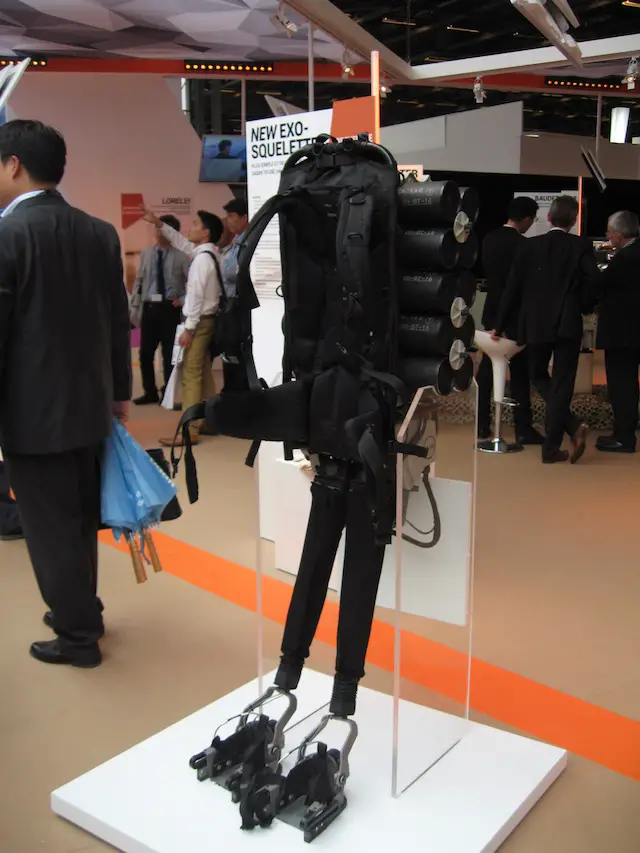
The "Hercule" exoskeleton takes the weight off the user's hand compared to the previous version and transfers it directly on the ground.
The company started the development of the exoskeletons in 2009 and the current model – the Hercules – is the fourth generation. Due to the exoskeletons’ dual natural, that is being ideal for the defence and the civilian market, the previous one was sold to a construction company.
Hercules is made of aluminum. It has a weight of 17 kg and can lift weights up to 60 kg. Its operation is powered by a set of batteries, which provide autonomy between three and six hours, depending on the use. It can be charged in three hours.
Hercules does not use any sensors to record the human motions. The system’s operation is based on an algorithm that “understands” the motion of the user’s limbs and follows them.
As Army Recognition has learned, the exoskeleton will undergo evaluation tests by the end of this year.
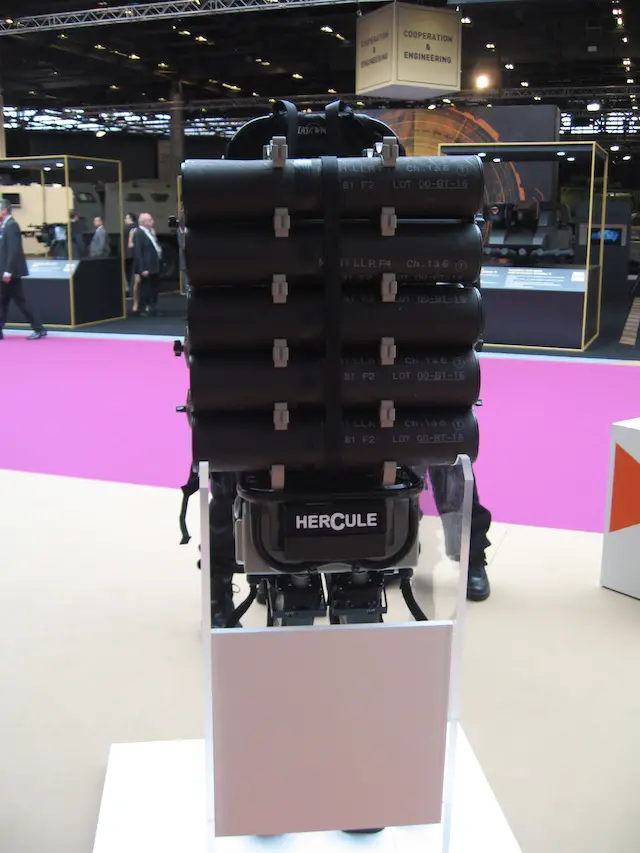
Researchers from Carnegie Mellon University have developed an exoskeleton clutch mechanism that barely weighs anything.
GM-NASA space robot partnership brings 'roboglove' to life
developed out of a partnership between general motors and for use on the international space station is being brought to life in health care, manufacturing and other applications though a licensing agreement between GM and bioservo technologies AB, a swedish medical technology company. working with GM, bioservo will combine technology from its ‘SEM Glove’ (soft extra muscle) technology with the ‘RoboGlove’, a force-multiplying wearable developed during GM and NASA’s nine-year collaboration that included the launch of ‘Robonaut 2′, a humanoid robot, into space in 2011. ‘combining the best of three worlds – space technology from NASA, engineering from GM and medtech from bioservo – in a new industrial glove could lead to industrial scale use of the technology’, said tomas ward, CEO of bioservo technologies. ward described the technology combination as a major step toward introducing soft exoskeleton technology globally.
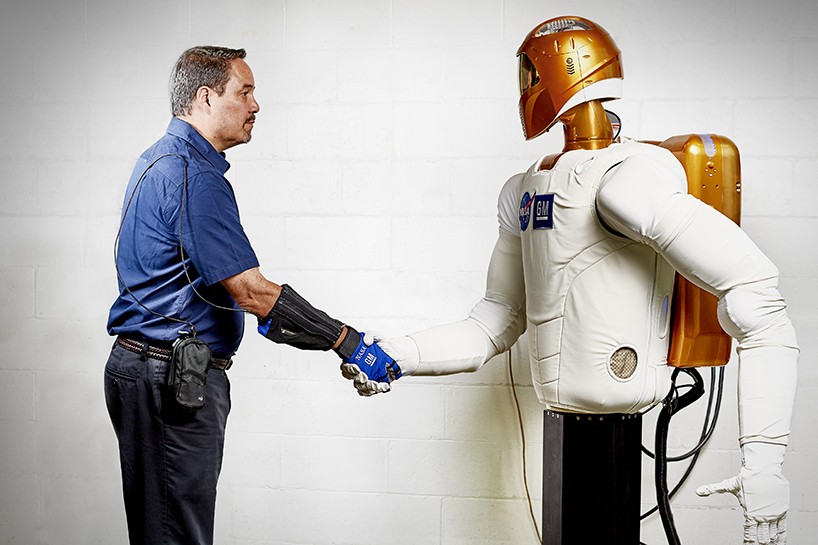
soft extra muscle technology is integrated into the design
the ‘RoboGlove’ uses leading-edge sensors, actuators and tendons that are comparable to the nerves, muscles and tendons in a human hand. one design requirement for ‘R2′ was to operate tools designed for humans, and developers achieved unprecedented hand dexterity. that technology was applied to the RoboGlove. will initially develop a new grasp assist device for industrial use that could increase efficiency while reducing fatigue in hand muscles. research shows fatigue can occur within a few minutes of continuously gripping a tool.
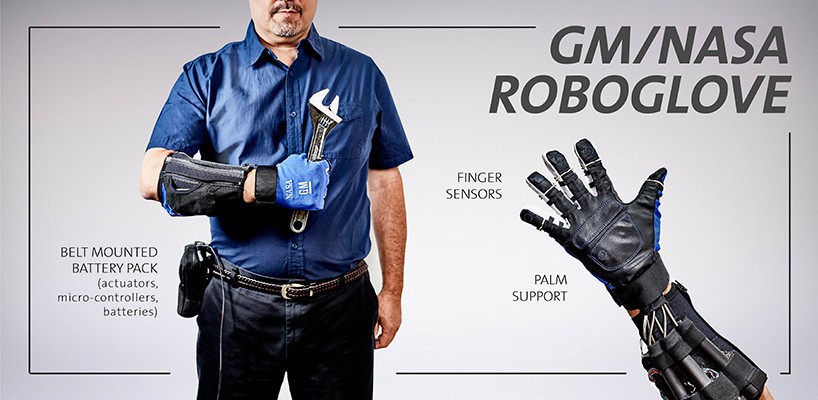
the grasp assist is aimed at reducing muscular fatigue in the hand
intends to be the first U.S. manufacturing customer for the refined robotic glove and will test it in some of its plants. bioservo will make and sell the new glove for a variety of uses including medical rehabilitation and any place additional gripping strength is needed. ‘The successor to RoboGlove can reduce the amount of force that a worker needs to exert when operating a tool for an extended time or with repetitive motions’, said Kurt Wiese, vice president of GM global manufacturing engineering. GM briefly tested ‘RoboGlove’ in a preproduction plant before looking for a partner to help refine it to fit different size hands and address other issues.
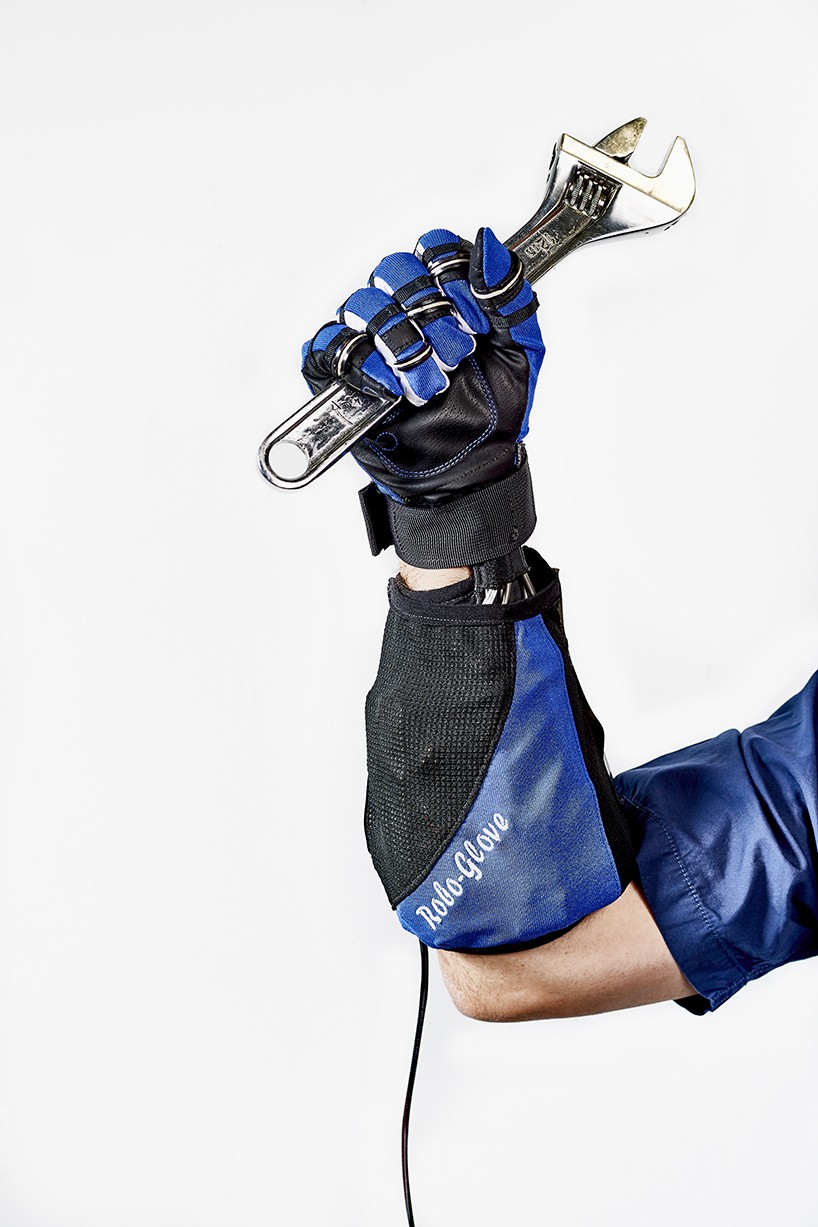
reduces the arm strain when holding a heavy tool
excerpt for full article readWearable Technology Could Change How Special Operations Forces Fight
August 2016
By Jon Harper
.....
Special operators training and assisting Iraqi forces would benefit from this technology during the hot summer months, he noted.
“A number of these fabrics are much more lightweight and shed heat better, and that’s not an insignificant matter when you’re a soldier and you’re carrying around a lot of weight,” he said.
In addition to being protected from the environment, commandos need body armor to shield them against enemy fire.
SOCOM will have a recompete for a ballistic plate contract in fiscal year 2019, Fields said. The command is also looking for new helmets that offer ballistic and impact protection. A solicitation is expected to go out to industry in the first quarter of fiscal year 2017, with a contract award anticipated in the third quarter.
Another item on SOCOM’s wish list is better eyewear.
“What I’m really looking for here is one of the ones that does it all — day, night, laser protection, perhaps something that does some active transitioning,” Fields said.
“It has to do it really fast,” he added. “We need to go from inside to outside, outside from inside, [and] the operators need to be able to not wait for their glasses to catch up with them.”
Officials are conducting market research to see what types of protection technologies are available, he said.
Perhaps the ultimate form of wearable armor is the tactical light operator suit, or TALOS. Nicknamed “the Iron Man suit” in reference to the fictional superhero, the aim of TALOS is to make special operators who kick in the door during raids essentially bulletproof. The powered exoskeleton is to be equipped with a communications suite and other enabling technologies.
SOCOM hopes to have a prototype ready by 2018, and officials have said the program is on track.
To push the technology forward, the command is promoting SOFWERX, its new rapid prototyping office. SOFWERX has already been put to use on the TALOS project to develop a base layer.
“Everybody thinks of the Iron Man suit exoskeleton,” said James “Hondo” Geurts, SOCOM’s acquisition executive, at the SOFIC conference. “What most people don’t think about is … what’s between that [metal suit] and human skin?”
Industry partners and different user groups recently teamed up to develop a solution.
“In 60 days we were able to turn full-up designs and prototypes so that we can start figuring out how are we going to solve this for the end suit,” Geurts said.
Wearable technology can help solve situational awareness problems.
Army Gen. Raymond Thomas III, the commander of SOCOM, was inspired by watching the movie “Minority Report” during a deployment to Afghanistan.
“I’m watching Tom Cruise do all his gizmo stuff, understanding everything in the world and I thought, ‘That’s what I want at the touch of a fingertip,’” he said. “I want to be able to bring everything we know … to the appropriate operator level.”
Even better would be a heads-up display system.
At some point “we’re going to interface artificial intelligence with our operators so they are literally hands free,” Thomas said. “At the voice prompt they’re going to be able to say, ‘Siri or Son of Siri or whoever, give me this [situational awareness information].’ And it’s going to drop down to a heads-up display and they’re going to have everything they need because it will all be in some file.”
Down the road, the SOCOM chief wants to integrate voice prompt technology into TALOS, noting that the first iteration of the suit will rely on button-enabled capabilities.
“I’m thinking, ‘OK, I can’t see buttons’” without looking down and taking eyes off the battlefield, he said. “I … want the next best version and so will our operators.”
Thomas’ dream might be on the path to coming true. The Defense Department’s rapid reaction technology office and the Army’s night vision and electronic sensors directorate have collaborated on an emerging capability prototyping project called HD Glass. SOCOM is slated to receive the new heads-up display equipment in September.
“The prevalence of smartphone applications for geolocation and information services has demonstrated how information can be a force multiplier for warfighters,” said an HD Glass project description published by the Defense Department.
But “increased battlefield awareness through smartphones, tablets and laptops comes at a cost of reduced awareness of immediate surroundings,” it said. “Heads-up displays provide an alternative human-technology interface that leverages the full capability of a smartphone, while maintaining ‘eyes out’ tactical awareness.”
Existing heads-up displays designed for aircraft pilots have insufficient field of view and contrast to meet the operational challenges of ground forces, according to the Pentagon’s acquisition office. HD Glass is intended to solve that problem.

The system consists of a high-definition, high-brightness, organic light-emitting diode see-through display mounted on a set of ballistic eyewear. The display will be integrated with a camera, sensors and electronics in a small, lightweight package that enables continuous all-day use, according to the project description.
It is designed to work with computing platforms such as Android operating systems, to provide an augmented reality overlay.
In this case, augmented reality refers to a live view of an environment with added situational awareness displays.
The phase one prototype, completed in April, demonstrated “an operational fit and function.” The phase two prototype, slated to transition to SOCOM and undergo an Army user assessment in September, includes “a versatile augmented reality interface.”
The system is intended to integrate with SOCOM’s Android tactical assault kit and the Army’s Nett Warrior system.
“It won’t be long, I guarantee you, before our combat infantrymen and women are using wearable electronics with uploadable combat apps and heads-up displays of their own,” Deputy Secretary of Defense Bob Work said at a conference last fall....
